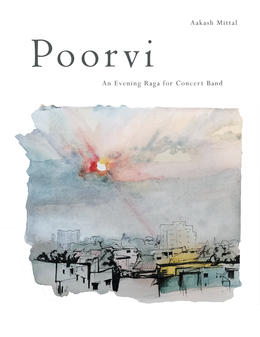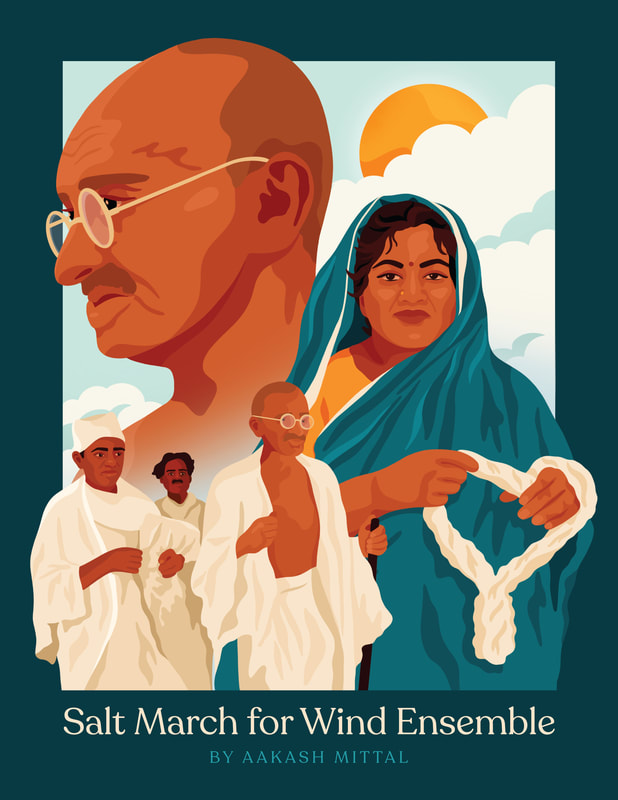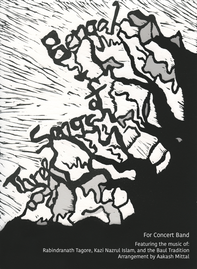Poorvi an evening raga for concert band
Salt March for wind ensemble
About Salt March for Wind Ensemble
In the spring of 1930 Mohandas K. Gandhi began a non-violent protest of British colonialism that would come to be known as the salt march. Starting from their ashram in Ahmedabad, India, Gandhi and his collaborators would walk 239 miles to the western coast. By making salt out of seawater, Gandhi challenged unjust laws that gave Britain a monopoly on salt production. This act of civil disobedience would, in Gandhi’s own words, “shake the foundation of the British empire” and lead toward Indian independence.
Salt March for Wind Ensemble will explore the concept of the march as non-violent protest rather than military celebration. The piece will weave the rhythms of south Asian processional drumming with melodies from the Indian raga tradition and an arrangement of songs associated with Mahatma Gandhi. The music will tell a story of Gandhi’s march for freedom.
Salt March for Wind Ensemble will explore the concept of the march as non-violent protest rather than military celebration. The piece will weave the rhythms of south Asian processional drumming with melodies from the Indian raga tradition and an arrangement of songs associated with Mahatma Gandhi. The music will tell a story of Gandhi’s march for freedom.
Instrumentation
|
Woodwinds
Piccolo (doubles Flute 1*) Flute 1 Flute 2 Oboe (doubles part*) Bassoon (doubles part*) Clarinet in Bb 1 Clarinet in Bb 2 Bass Clarinet Alto Saxophone Tenor Saxophone Baritone Saxophone (doubles part*) |
Brass
Trumpet in Bb 1 Trumpet in Bb 2 & 3 Horn in F 1 & 2 (doubles*) Trombone 1& 2 Euphonium Tuba Strings Electric Bass (optional) |
Percussion
Timpani Percussion 1 Snare Drum Percussion 2 Tambourine Percussion 3 Suspended Cymbal with soft mallets, Crash Cymbals Percussion 4 Low Tom Percussion 5 Bass Drum Percussion 6 Optional Aux Percussion |
*These instruments will double other parts making them optional for bands who don’t have the full instrumentation.
Three Songs of Bengal
A three-movement arrangement of Bengali songs for concert band.
About the piece
While living in West Bengal with the goal of studying Hindustani Raga Music, I regularly experienced the vast repertoire of Bengali composers and songwriters. As a person of Punjabi-Euro origin the music of Bengal utilized instruments, sounds, and song forms I had never encountered. During my stay I played saxophone along side Baul singers in Tanmoy Bose's band Taal Tantra. I listened to the poetry and songs of Tagore at chai stands, on concert stages, and on rooftops. These experiences struck me as an important testament to the plurality of South Asia's cultural landscape. As a followup to my first wind ensemble piece, Samay Raga, Three Songs of Bengal is a reflection on the music I encountered within Bengali communities. Each movement is an instrumental arrangement of a traditional Bangla (Bengali) song for concert band. The piece begins with a song composed by Rabindranath Tagore, the polymathic artist, poet, playwright, composer, and activist who was an important figure in the Bengal Renaissance. The second movement is by Kazi Nazrul Islam who was nicknamed the "rebel poet" for his dissent against the British Empire and the cultural hegemony of Tagore. The piece concludes with a song from the Baul tradition, a community of wandering minstrels whose music centers nature themes and the body.
Aakash Mittal-
While living in West Bengal with the goal of studying Hindustani Raga Music, I regularly experienced the vast repertoire of Bengali composers and songwriters. As a person of Punjabi-Euro origin the music of Bengal utilized instruments, sounds, and song forms I had never encountered. During my stay I played saxophone along side Baul singers in Tanmoy Bose's band Taal Tantra. I listened to the poetry and songs of Tagore at chai stands, on concert stages, and on rooftops. These experiences struck me as an important testament to the plurality of South Asia's cultural landscape. As a followup to my first wind ensemble piece, Samay Raga, Three Songs of Bengal is a reflection on the music I encountered within Bengali communities. Each movement is an instrumental arrangement of a traditional Bangla (Bengali) song for concert band. The piece begins with a song composed by Rabindranath Tagore, the polymathic artist, poet, playwright, composer, and activist who was an important figure in the Bengal Renaissance. The second movement is by Kazi Nazrul Islam who was nicknamed the "rebel poet" for his dissent against the British Empire and the cultural hegemony of Tagore. The piece concludes with a song from the Baul tradition, a community of wandering minstrels whose music centers nature themes and the body.
Aakash Mittal-
Sample Score and Recording
| three_songs_of_bengal_brooklyn_wind_symphony.mp3 | |
| File Size: | 4872 kb |
| File Type: | mp3 |
| score_three_songs_of_bengal_sample_score.pdf | |
| File Size: | 5827 kb |
| File Type: | |
Instrumentation
|
Winds
Flute Oboe Bassoon Clarinet in Bb 1 Clarinet in Bb 2 Bass Clarinet Alto Saxophone Tenor Saxophone Baritone Saxophone |
Brass
Trumpet in Bb 1 Trumpet in Bb 2 Horn in F Trombone Euphonium Tuba Strings Electric Bass (optional) Ek Tara or Guitar (optional) |
Percussion
Timpani Percussion 1 Bass Drum Percussion 2 Claves, Crash Cymbals, Finger Cymbals, Singing Bowl, Suspended Cymbal with soft mallets, Tom-toms Percussion 3 Snare Drum Percussion 4 Drum Set (with Bass Drum, Floor Tom, Hi Hat, High Tom, Snare Drum, and Ride Cymbal), Suspended Cymbal with soft mallets, Tambourine Percussion 5 Glockenspiel and Wind Chimes Tabla (optional) |


